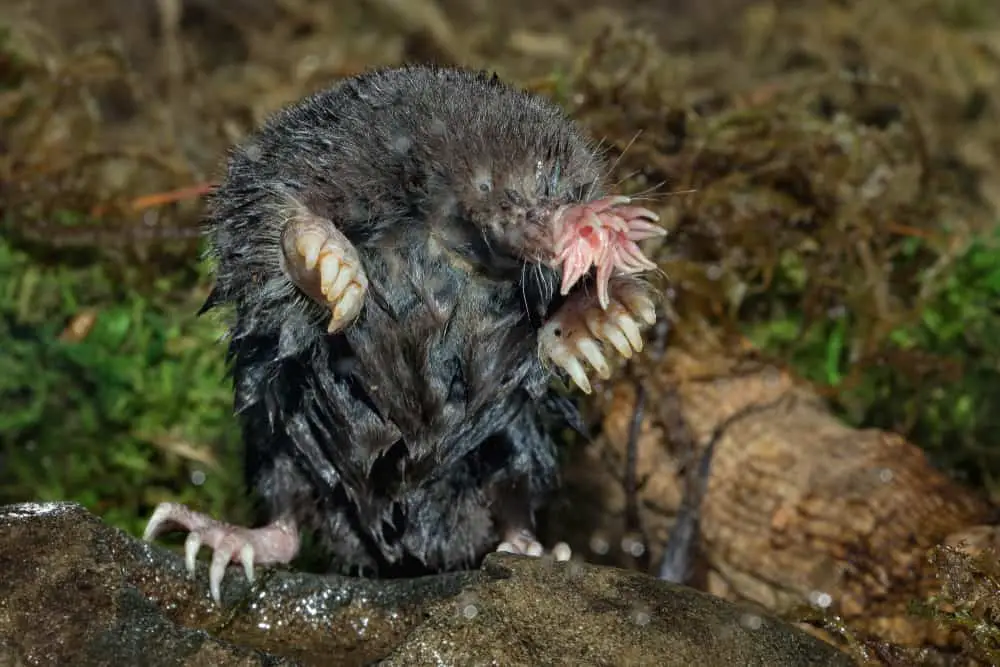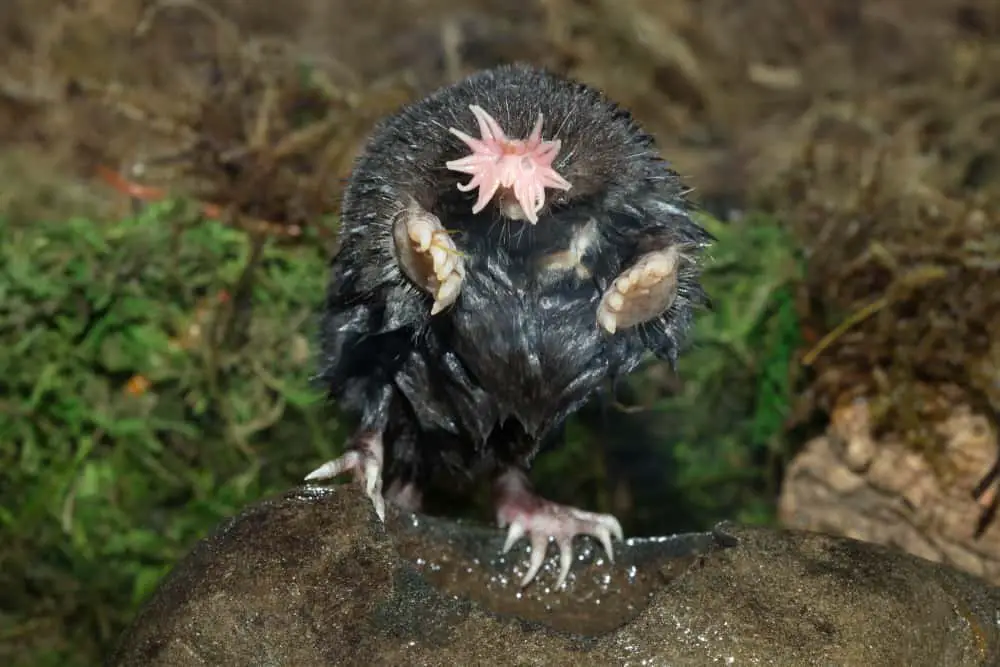The star-nosed mole (Condylura cristata) is an extraordinary mammal species endemic to North America. This small, semi-aquatic creature boasts a fascinating anatomical feature that sets it apart from other mammals: A highly sensitive and distinctively shaped nose referred to as the ‘star’ which gives the animal its name. Thanks to this unique adaptation, the star-nosed mole has become well known among wildlife biologists due to its remarkable sensory capabilities and behavior.
The star-nosed mole exhibits a range of physiological adaptations that make it well suited for life in wetland habitats including dense fur, webbed feet and several specialized organs used for sensing prey items underwater. Its most notable trait however, lies within its distinctive nose; comprised of 22 appendages arranged in a radial pattern resembling a ‘star’.
Each appendage contains thousands of tiny touch receptors called Eimer’s organs which are used by the animal to detect food items hidden beneath the surface soil or mud of its marshy habitat.
This article explores how such an unusual morphology evolved and what ecological role it plays in the lives of these subterranean creatures. It will also discuss some aspects of their natural history, behavior and distribution throughout North America.

Overview
The star-nosed mole (Condylura cristata) is a small mammal that belongs to the family of moles. It inhabits wet lowland areas in eastern North America, including parts of Canada and the United States. This species has distinctive sensory organs located around its nose, which take the form of 11 pairs of pink tentacles arranged in a circle resembling a star.
The star-nosed mole uses these specialized appendages to locate food as well as navigate through underground tunnels.
The body length of this mole species ranges from 8 to 15 centimeters with an average weight between 30 and 65 grams. Its fur coat consists mainly of black hairs but may also possess brown or gray coloring on some individuals.
Star-nosed moles have powerful front claws for digging complex burrows beneath the surface soil and are capable swimmers due to their webbed paws. These adaptations enable them to live primarily in waterlogged environments such as marshes and wetlands where they feed on aquatic invertebrates like worms and insects.
An interesting feature unique to the star-nosed mole is its remarkable sensitivity; it can detect objects smaller than 35 millionths of a meter – 100 times more sensitive than human touch! This provides additional advantages when searching for prey in mud or murky waters.
With such an impressive array of senses, this unusual creature continues to captivate scientists seeking answers about how animals survive in their respective habitats.
Habitat And Distribution
The habitat range and distribution of the star-nosed mole has been studied extensively by biologists. The species is widely distributed throughout North America, ranging from Northern Canada to New Jersey in the east and parts of California and Oregon in the west.
Biologists have created a map that illustrates its primary native habitat locations, which includes regions consisting of coastal wetlands, marshlands, wet meadows and wooded areas with moist soil.
These moles are adapted to living in very wet habitats due to their specialized furless nose covered with 22 fleshy tentacles called rays that help them detect prey underwater. They also possess webbed feet that allow them to swim effectively while searching for food in shallow water or mudflats.
Star-nosed moles are able to survive in both fresh and saltwater environments because they can regulate the amount of sodium absorbed by their bodies through specialized cells located on their tongue and gills.
Human activities such as deforestation, urbanization, pollution, agricultural expansion and climate change have impacted natural habitats around the world leading to significant losses for many species including star-nosed moles. Conservation efforts need to be taken seriously if we want this species to remain an important part of our local ecosystems for years to come.
Anatomy And Physiology
The star-nosed mole is an unusual species of mammal due to its unique snout anatomy. The nose consists of 22 pink and fleshy appendages, known as tentacles, which form a distinctive star pattern around the nostrils. These tentacles are highly sensitive organs that are adept at sensing movement within their immediate environment, allowing them to locate prey items quickly and accurately.
The burrowing anatomy of this species is also adapted for efficient food capture; they have short limbs with powerful claws that enable them to tunnel through soil rapidly in search of food sources such as earthworms and aquatic invertebrates. In addition, their uniquely designed fur helps protect against moisture loss during extended periods underground.
The physiology of the star-nosed mole has been extensively studied by biologists who suggest it is well suited to life in wetland habitats. Its body temperature remains constant regardless of environmental conditions and its lungs can function both above ground and underwater – making it one of very few mammals able to breathe submerged in water.
Furthermore, their ability to sense electric fields emitted from other animals allows them to detect potential prey even when visibility is severely reduced or absent altogether.
In summary, the star-nosed mole demonstrates remarkable adaptations which allow it to survive in harsh wetland environments where many other similarly sized creatures would struggle.
Behavior And Diet
The star-nosed mole is a unique species of mole that can be found in wetlands and damp lowland areas throughout North America. It is an expert forager, relying on its extraordinary sense of touch to locate food sources. The star-shaped nose contains more than 25,000 sensory receptors which the animal uses to detect prey hidden beneath the surface or among vegetation.
Its eating habits are quite remarkable; it has been observed consuming up to 200 small items per hour – such as worms, aquatic insects and mollusks – using its 11 pairs of pink fleshy tentacles located around its snout. Its diet also includes plant material such as roots and seeds.
The star-nosed mole is solitary by nature, but does have certain social behaviors when interacting with other individuals of the same species. Burrowing activities usually occur alone but at times two or three individuals may share one burrow system – though never sharing living quarters. These underground tunnels provide safety from predators and often contain extensive networks with many exits leading to different habitats used for foraging purposes.
It spends most of its time underneath the ground searching for food sources while avoiding detection from potential predators like snakes, skunks and owls during daylight hours. At night they will come out into open areas to feed before quickly retreating back below ground level again.
Reproduction And Life Cycle
The star-nosed mole is known for its unique reproductive cycle. Its life expectancy averages about five years, but can reach up to eight in the wild. The mating habits of this animal are not well understood, as it generally lives alone and only comes together with another during courtship and copulation.
When pregnant, female moles give birth to litters averaging four offspring at a time. During the birth process she will construct an underground chamber that provides her young with protection from predators until they mature enough to venture out on their own.
Despite having such small litters, females have been observed caring for multiple generations of offspring over the course of several breeding seasons. As such, there is some evidence that mothers may provide extended care by nursing and protecting younger siblings even after they’ve reached maturity themselves.
Star-nosed moles exhibit strong parental behavior which helps ensure the survival of their species across different habitats throughout North America. This species has adapted various strategies to protect their young while simultaneously continuing to reproduce each year, making them successful inhabitants in most environments they inhabit.

Predators And Threats
The Star-nosed Mole (Condylura cristata) is a small mammal that has adapted to life in North American wetlands and marshes. Its unique star-shaped nose distinguishes it from other species of mole, allowing it to detect prey by touch.
Although the Star-nosed Mole feeds mainly on invertebrates, larger predators such as meadow voles, members of the weasel family, burrowing owls, and carnivorous mammals may take advantage of this vulnerable creature when available.
The Star-nosed Mole’s main defense against predation is its speed; however, it can also be protected by its underground burrows or tunnels which are hidden from view. These tunnels provide shelter from birds of prey and surface dwelling predators like coyotes and foxes. The Star-nosed Mole can also hide within dense vegetation during the day while they forage at night.
Despite these measures taken by the Star-Nosed Moles to protect themselves, they remain susceptible to many predators due to their size and habits. They often venture out into open areas to search for food which puts them at risk of becoming meals for large predatory animals including hawks and owls in addition to smaller mammals such as cats and dogs.
Humans have also been known to hunt these small creatures for food or sport with traps or guns. Their population numbers have decreased over time due to habitat loss caused by humans as well as increased predation rates from invasive species introduced into their habitats.
Conservation Status
The conservation status of the star-nosed mole is a pressing concern for wildlife biologists and environmentalists alike. With its limited range and vulnerability to habitat destruction, this species may be at risk of becoming an endangered species in the future. In order to protect this unique creature from potential threats, it is important to take steps now to ensure their survival.
Through research and monitoring, we can better understand which conservation strategies are necessary to help preserve this species’ population size.
Conservation efforts include protecting habitats by creating buffer zones or corridors connecting larger areas of suitable habitat, reducing human disturbance such as pollution and fishing activities, establishing protected areas, developing land management plans that prioritize biodiversity protection, and conducting educational campaigns about the importance of preserving ecosystems.
Additionally, propagation programs could be implemented in cases where populations have become low due to anthropogenic disturbances.
These conservation efforts should also involve collaboration among multiple stakeholders including local communities who depend on these ecosystems for resources like food and fuelwood as well as with non-governmental organizations (NGOs) working towards species conservation goals globally.
As part of this collaborative effort, effective conservation management must incorporate both legal regulations enforced by authorities as well as voluntary solutions proposed by citizens living near affected sites. This combined approach helps address socio-economic needs while still providing adequate protections for threatened animals like the star-nosed mole.
By engaging all involved parties in meaningful dialogue about the need for species conservation and applying best practices accordingly, we will hopefully be able to secure a safe future for this remarkable animal.
Conclusion
The star-nosed mole is an incredibly fascinating creature. Its distinct anatomy and physiology, coupled with its specialized behavior and diet, have allowed it to flourish in the wetlands of North America. With a highly developed sense of touch, these moles forage for food using their unique tentacles located around their nose, which allows them to detect prey even in complete darkness. They are also adept swimmers that often swim beneath the water’s surface as they search for food.
Reproduction occurs during late winter or early spring when male moles establish territories and attract mates by vocalizing. Upon mating, females will produce litters ranging from 2 – 7 offspring after a gestation period of 4 weeks. Predators such as owls, hawks, foxes and snakes threaten adult moles but young ones may be vulnerable to shrews and other small mammals.
Fortunately due to widespread conservation efforts over the past several decades, the population status of this species has moved from endangered to least concern according to IUCN standards. This remarkable animal continues to captivate researchers who strive to understand more about its amazing adaptations and behaviors while working towards preserving its habitat and future generations of star-nosed moles.

